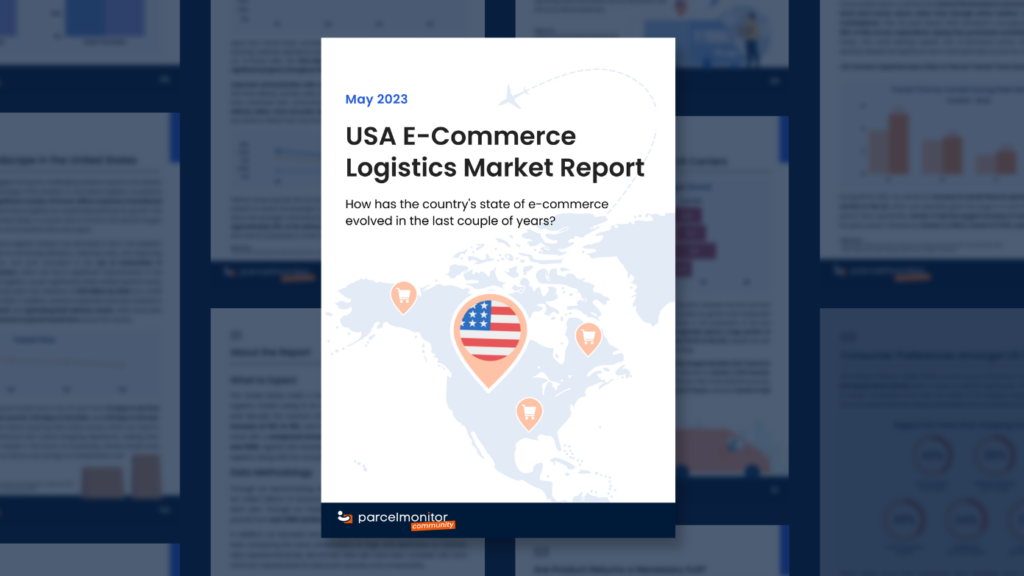Did you know: the USA has the second-largest e-commerce market in the world, just after China? In fact, online sales in the USA have shown consistent yearly growth of 13% to 18% over the past 10 years, and the market is anticipated to keep growing at a compound annual growth rate (CAGR) of over 6% between 2023 and 2028.
E-commerce landscape in the US
The US e-commerce logistics industry has recently embraced innovative technologies to enhance efficiency, reduce costs and improve the customer experience. One notable innovation is the implementation of automation in warehouses and distribution centers, leading to significant improvements in the speed and accuracy of order fulfillment.
According to Parcel Monitor, the transit time for parcels in the USA has decreased steadily over the past year. In the first quarter of 2022, it took an average of 3.5 days for a parcel to reach its destination. However, by the fourth quarter, the transit time had reduced to just 2.19 days. Shorter transit times are beneficial for customers as they receive their orders more quickly, leading to higher satisfaction and an improved shopping experience. This, in turn, increases the likelihood of customers returning to the same retailer in the future. For businesses, shorter transit times can result in higher order volumes and long-term cost savings in transportation and logistics.
Besides transit times, the successful delivery of parcels on the first attempt is crucial for enhancing customer experience and retention in retail and e-commerce. According to Parcel Monitor’s data, the first-attempt success rate for parcel deliveries in the USA showed significant improvement throughout 2022. It increased steadily from 83% in the first quarter to 98% in the fourth quarter. One possible contributing factor to this improvement is enhanced communication with customers. Delivery companies may have achieved this by providing more accurate estimated delivery dates, real-time tracking updates, and timely notifications regarding any issues or delays encountered during the order fulfillment process.
Consumer preferences amongst US shoppers
In recent years, sustainability has gained significant attention, especially in the logistics and fulfillment industry. To lessen their influence on the environment, more businesses are realizing the value of incorporating sustainable practices into their operations. One such practice is the use of alternate last-mile delivery methods. Nevertheless, collection point use in the USA decreased from 2.9% in H1 2022 to 2% in H2 2022. However, over the same period, the average dwell time for packages at the aforementioned collection stations increased from 49% to 52%.
During a recent survey, 42% of US consumers who were asked about their e-commerce challenges named “lack of product information” as the main frustration. A lack of user-friendly websites (38%), poor inventory visibility (38%), subpar support for consumers (34%), and a lack of payment choices (17%) are some of the other significant issues that US shoppers encountered. These difficulties may negatively impact customers’ shopping experiences, cause annoyance, and reduce revenue for e-commerce companies around the world.
Peak season performance by US carriers
The peak season is undoubtedly the most demanding time of the year for individuals involved in e-commerce logistics. It holds immense significance for carrier performance since it directly affects the survival and long-term success of businesses. If carriers fail to meet expectations and cause delays or loss of shipments, customers may become dissatisfied and choose to take their business elsewhere.
In the realm of e-commerce logistics, the time it takes for items to travel from a merchant’s premises or warehouse to the end consumers’ hands is referred to as the average duration between the initial and final events of the order fulfillment process. It is noteworthy that despite the last mile being widely recognized as the most costly stage of the delivery process, shipments often spend a substantial amount of time in the first and middle mile (ranging from 70.6% to 84.3%).
During the peak season of 2022, Parcel Monitor examined four US carriers and observed the duration of the first two delivery phases. Among these carriers, Carrier B had the longest duration of 24.1 hours, followed by Carrier C with 23.3 hours, Carrier D with 23.1 hours, and Carrier A with 23 hours. When it came to completing the final mile of the fulfillment journey, Carrier C took the longest time of 9.7 hours, while Carrier D was the quickest, taking only 4.3 hours.
To find out more and download the report from Parcel Monitor, click here.


